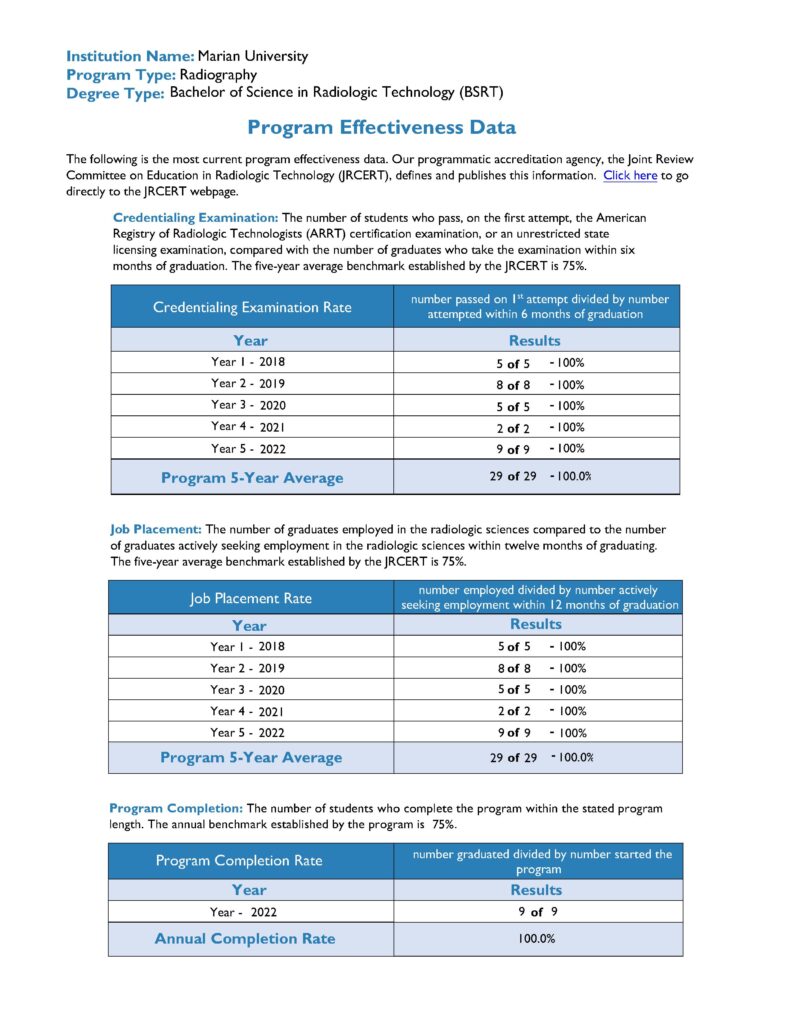Bachelor of Science in Radiologic Technology
Become a Nationally Certified Registered Radiologic Technologist and a Wisconsin Licensed Radiographer
As one of the first schools in Wisconsin to offer a Bachelor of Science in Radiologic Technology, we’ve developed a JRCERT accredited curriculum for students to not only become a registered radiologic technologist, but also a leader in the healthcare industry.
Following sophomore year, you’ll spend approximately 40 hours each week for 22 months both in the classroom studying radiologic technology theory and at clinical agency sites in Appleton, Oshkosh, Fond du Lac, and Waupun, applying that knowledge by working with real patients.
Our clinical experiences start building your skills – many from Day 1. Get hands-on training performing venipuncture, taking x-rays, managing CT and MRI machines, all while receiving immediate feedback to ensure you’re prepared to work. Gain valuable experience in CT and MRI suites, interventional cardiovascular procedures, operating rooms and imaging procedures in the ER, ICU and patient rooms.
Graduating with a bachelor’s degree opens up future career opportunities in management/administration, education/training, sales, and application specialist positions.
Are you already a licensed RT and would like to complete your bachelor’s degree? Marian University offers a Radiologic Technology completion degree where you can earn your bachelor’s 100% online.
Learn to become a licensed Rad Tech through classroom and clinical training!
Learn More About the Radiologic Technology Program
Listen to Teri Durkin, Academic Advisor in Allied Health, as she explains what degrees are offered, what an academic advisor does and how they help students navigate their college classes/major/schedule, and the medical imaging programs. Medical imaging programs include diagnostic medical sonography and radiologic technology that focus on direct patient care. Ms. Durkin provides an overview of GPA requirements, clinical hours, admission requirements and processes, and clinical site options for diagnostic medical sonography and radiologic technology.
Learning the Equipment
Build skills in conducting medical imaging tests:
- Computed tomography (CT)
- Magnetic resonance imaging (MRI)
- Interventional radiology and cardiology
- Surgical, portable, and pain management procedures
- Diagnostic radiographic examinations and fluoroscopic procedures
BS in Radiologic Technology Curriculum
Our BSRT program features a carefully crafted curriculum that integrates extensive hands-on learning with a valuable liberal arts core. Experiential learning opportunities are offered in diagnostic radiographic examinations and fluoroscopic procedures, as well as many specialized areas in surgical and portable procedures, pain management procedures, interventional radiology and cardiology procedures, computed tomography, and magnetic resonance imaging. Students can also arrange for observational experiences in ultrasound, nuclear medicine, and radiation therapy. Students in this JRCERT accredited program rotate through eight healthcare facilities to gain exposure to several settings, including surgical, emergency, and outpatient environments.
General Education Courses
As a bachelor’s level student, you are required to take about 30 credits of general education courses as part of the 120 credits required for a bachelor’s degree. Gen eds are required regardless of your major.
All students take 10.5 to 17 credits in these areas:
- Mathematical Reasoning
- Argumentative and Research Writing
- Introduction to Christian Theology
- Interpersonal Communication
- Introduction to Ethical Reasoning
- First Year Studies
Core Courses
Radiologic technology majors will take courses covering topics such as:
- Medical terminology
- Patient care in radiologic sciences
- Principles of radiation protection and biology
- Imaging equipment and quality control
- Anatomy and physiology
American Registry of Radiologic Technologists (ARRT)
Upon completion of the Radiologic Technology Program, you will be awarded with the Bachelor of Science in Radiologic Technology (BSRT) degree. The completion of this degree will make you eligible to sit for the American Registry of Radiologic Technologist national certification examination. The ARRT is the certifying organization form for radiographers. Students will be eligible to apply to sit for the examination during the final semester of the Program. Individuals that pass the examination are bestowed the title “Registered Technologist” (R.T.)
American Society of Radiologic Technologists (ASRT)
The American Society of Radiologic Technologists is a national organization that develops and publishes the Radiography Curriculum. This document outlines the essential knowledge that individuals, with the goal of entering the profession of radiologic sciences, should acquire while attending an accredited educational program.
Joint Review Committee on Education in Radiologic Technology (JRCERT)
The Joint Review Committee on Education in Radiologic Technology has established the Standards for an Accredited Educational Program in Radiography by which the Program’s educational policies and procedures must meet in order to verify compliance and be in good standing with the JRCERT.
Student Learning Outcomes
The following are the student learning goals and associated outcomes of the program:
Goal: Students will graduate as a clinically competent radiographer
Student Learning Outcomes:
- Students will apply appropriate radiation protection practices.
- Students will apply appropriate positioning skills.
- Students/graduates will select appropriate technical factors.
Goal: Students will utilize critical thinking, problem solving and decision making skills
Student Learning Outcomes:
- Students will evaluate a radiograph for diagnostic quality.
- Students will access the patient and have the ability to adapt to non-routine situations/ability to adjust exam for patient condition.
- Students will demonstrate the ability to maintain poise/calmness during tense clinical situations.
Goal: Students/graduates will communicate effectively
Student Learning Outcomes:
- Students will be able to orally relate/interrelate with patients.
- Students/graduates will demonstrate proper communication skills with health team members.
Goal: Students/graduates will demonstrate the importance of professional growth and development
Student Learning Outcomes:
- Students/graduates will be able to demonstrate professional values in the clinical setting.
- Students/graduates will exhibit involvement in educational advancement as a radiographer.
Program Effectiveness Data and Outcomes
Below are program goals and associated outcomes. The yearly results and five-year average for the first, fourth, and fifth outcome can be found under the Program Effectiveness Data link.
Goal: The program will graduate entry-level technologists.
Program Outcomes:
- Students will pass the ARRT Registry on the first attempt within 6 months of graduation.
- Employer’s attitude regarding rehiring the graduate if given a second opportunity.
- Alumni’s satisfaction regarding being prepared with entry-level skills.
- Of those seeking employment, students will be gainfully employed within 12 months of graduation.
- Students that begin the program will graduate from the program.
Radiologic Technology Mission Statement
As a faith-based university our program prepares students to provide radiologic services at an entry level with an emphasis on quality patient care and technical competency. We give students practicum experience in advanced imaging modalities that enhances their clinical education and professional opportunities.
Originated 5/12; Reviewed 6/13, 6/14, 6/17, 5/18, 5/19, 5/20; Revised 6/15, 1/16
Philosophy
The program philosophy has two primary focuses: technical competency and patient care.
Our faculty believe in demonstrating expertise while minimizing the amount of ionizing radiation exposure to patients, themselves and all members that comprise the health care team. To provide the highest quality care possible students must demonstrate valuing lifelong learning so that they may maintain and improve their technical skills.
Students should demonstrate ethical conduct and act in the best interest of the patient without discrimination on the basis of sex, race, creed, religion, socioeconomic states, or nature of disease or illness, while protecting the right of the patient to experience quality radiologic technology care. To provide the best possible care radiologic technologists must demonstrate accountability for obtaining critical patient history through observation and communication with the physician, while respecting the patient’s right to privacy. Radiologic technologists must also recognize that interpretation and diagnosis of radiographic images is not part of the Scope of Practice.
PROGRAM EFFECTIVENESS DATA
In addition to student learning goals and outcomes, the performance of the program is measured through program effectiveness data determined by the Joint Review Committee on Education in Radiologic Technology (JRCERT.) Program effectiveness data includes program completion rate, ARRT credentialing pass rate and job placement rate.
Note: regarding job placement statistic, the JRCERT has defined “not actively seeking employment” as:
- Graduate fails to communicate with program officials regarding employment status after multiple attempts OR
- Graduate is unwilling to seek employment that requires relocation OR
- Graduate is unwilling to accept employment due to salary or hours OR
- Graduate is on active military duty OR
- Graduate is continuing education
For program effectiveness data please refer to the JRCERT website at: https://www.jrcert.org/resources/program-effectiveness-data/
The program is accredited by JRCERT and upholds the professional standards required of all Radiologic Technology programs nationwide.
Joint Review Committee on Education in Radiologic Technology (JRCERT)
Our program is fully accredited (8 – year accreditation award) by the Joint Review Committee on Education in Radiologic Technology (JRCERT). The JRCERT promotes excellence in education and enhances quality and safety of patient care through the accreditation of educational program. The JRCERT is the only agency recognized by the U.S. Department of Education for the accreditation of educational programs in radiography.
The JRCERT has established the “Standards for an Accredited Educational Program in Radiography” by which the program’s educational policies and procedures must meet in order to verify compliance and be in good standing with the JRCERT. The “Standards for an Accredited Educational Program in Radiography” can be found at www.jrcert.org. or by contacting the JRCERT at:
JRCERT
20 N. Wacker Drive
Suite 2850
Chicago, IL 60606-3182
(312) 704-5300
Students have the right to submit allegations against a JRCERT accredited program if there is reason to believe that the program has acted contrary to JRCERT accreditation standards or that conditions at the program appear to jeopardize the quality of instruction or the general welfare of its students.
Marian University is accredited by the Higher Learning Commission.
Admission Policies
Our program at SSM St. Agnes Hospital in Fond du Lac has earned a truly esteemed reputation largely because of the success graduates have achieved throughout Wisconsin. When you complete the program, you will be eligible to sit for the American Registry of Radiologic Technologists (ARRT) national examination and, upon passage, will be granted the title of Radiologic Technologist – Registered (R.T., R.). Since the program was created in 2013, all graduates of Marian University’s Radiologic Technology Program at SSM St. Agnes Hospital in Fond du Lac have achieved a 100% pass rate on the first attempt on the ARRT exam while ranking between the 92nd-98th percentile nationally.
Radiologic Technology Student Essential Capabilities
Radiologic Technology Admission Criteria
Program Transfer Policy
Marian University’s Radiologic Technology program does not accept students who wish to transfer mid-program. Students who wish to enter the program must meet all admissions criteria and complete the application process for admission consideration.
Students not accepted into Marian’s program at Ascension Mercy Hospital in Oshkosh can apply to one of Marian’s clinical affiliate partners.
It is the policy of Marian University’s Radiologic Technology Program that, upon completion of the Program, all students must have successfully completed all didactic and clinical competency requirements as identified in the ARRT Didactic and Clinical Competency Requirements documents in place at the time of program completion. The ARRT Program Completion Verification Form (PCVF) will be signed by the Program Director only after students have completed all of the following requirements below. Completion of the PCVF is a requirement prior to students being granted eligibility to sit for the ARRT certification examination.
Program Completion Requirements:
-
- Satisfied all requirements of the Program Progression Policy.
- Completed all required Clinical Competency Requirements of the program.
- Satisfied all requirements of the Attendance Policy regarding absence during any Radiographic Clinical Practicum course.
Brian Joachim, M.S., R.T.(R)(ARRT)
Assistant Professor/Program Director
Radiologic Technology Program
920-926-5216
bwjoachim03@marianuniversity.edu
Tabitha Miller, M.S., R.T.(R)(ARRT)
Assistant Professor/Clinical Coordinator
920-926-5217
tamiller25@marianuniversity.edu
Clinical Education and Obligations
Radiologic Technology Academic Schedule
Radiologic Technology Academic Grading
Radiologic Technology Course Fees
Radiologic Technology Miscellaneous Non-Course Fees
Financial Aid, tuition and refunds
Printed versions of documents on this page are available upon request. Please contact admission@marianuniversity.edu


